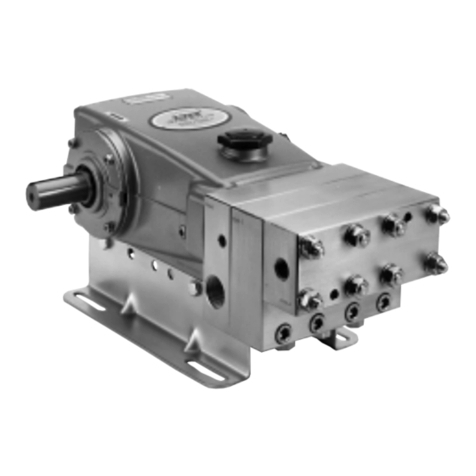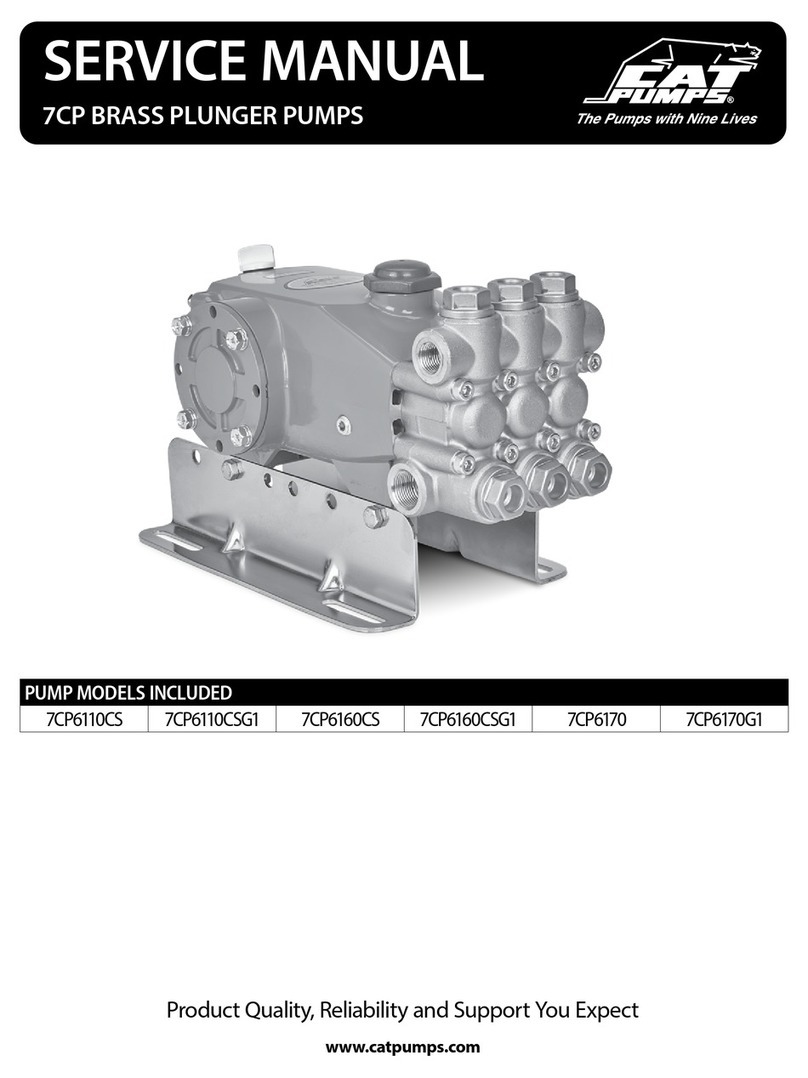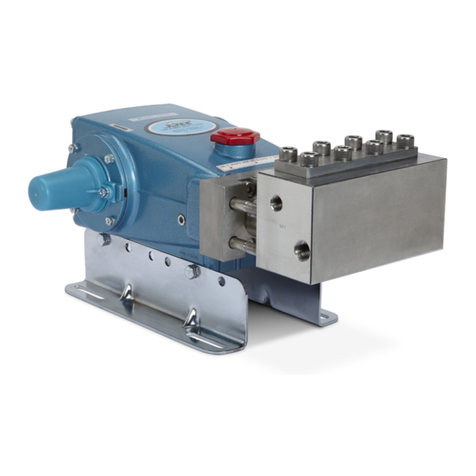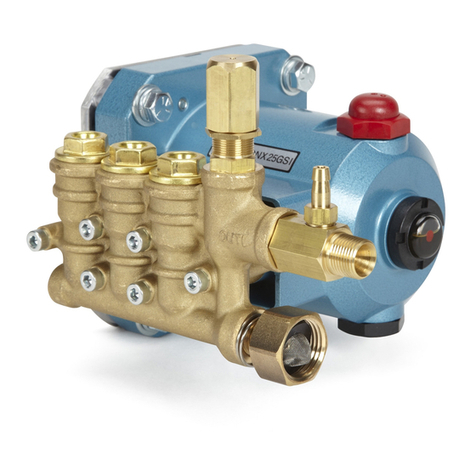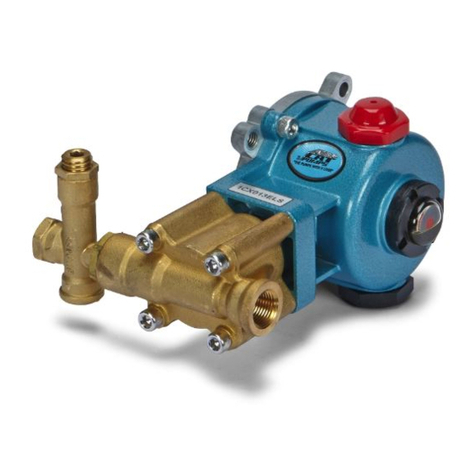
INLET CONDITION CHECK-LIST
Review Before Start-Up
Inadequate inlet conditions can cause serious malfunctions in the best
designed pump. Surprisingly, the simplest of things can cause the most
severe problems or go unnoticed to the unfamiliar or untrained eye.
REVIEW THIS CHECK-LISTBEFORE OPERATION OFANYSYSTEM.
Remember, no two systems are alike, so there can be no ONE best
way to set-up a system. All factors must be carefully considered.
INLET SUPPLY should exceed the maximum flow being delivered by the
pump to assure proper performance.
❏Open inlet shut-off valve and turn on water supply to avoid starving the
pump. DO NOT RUN PUMP DRY.
❏Temperatures above 130°F are permissible. Add 1/2 PSI inlet pressure
per each degree F over 130°F. Elastomer or RPM changes may be
required. See Tech Bulletin 002 or call CAT PUMPS for recommendations.
❏Avoid closed loop systems especially with high temperature, ultra-high
pressure or large volumes. Conditions vary with regulating/unloader
valve.
❏Higher temperature liquids tend to vaporize and require positive heads.
❏When using an inlet supply reservoir, size it to provide adequate
liquid to accommodate the maximum output of the pump, generally a
minimum of 6-10 times the GPM (however, a combination of system fac-
tors can change this requirement); provide adequate baffling in the tank
to eliminate air bubbles and turbulence; install diffusers on all return
lines to the tank.
INLET LINE SIZE should be adequate to avoid starving the pump.
❏Line size must be a minimum of one size larger than the pump inlet
fitting. Avoid tees, 90 degree elbows or valves in the inlet line of the
pump to reduce the risk of flow restriction and cavitation.
❏The line MUST be a FLEXIBLE hose, NOT a rigid pipe, and reinforced
on SUCTION systems to avoid collapsing.
❏The simpler the inlet plumbing the less the potential for problems. Keep
the length to a minimum, the number of elbows and joints to a minimum
(ideally no elbows) and the inlet accessories to a minimum.
❏Use pipe sealant to assure air-tight, positive sealing pipe joints.
INLET PRESSURE should fall within the specifications of the pump.
❏Acceleration loss of liquids may be increased by high RPM, high
temperatures, low vapor pressures or high viscosity and may require a
pressurized inlet to maintain adequate inlet supply.
❏Optimum pump performance is obtained with +20 PSI (1.4 BAR) inlet
pressure. With adequate inlet plumbing, most pumps will perform with
flooded suction. Maximum inlet pressure is 75 PSI (5.25 BAR).
❏After prolonged storage, pump should be rotated by hand and purged
of air to facilitate priming. Disconnect the discharge port and allow liquid
to pass through pump and measure flow.
INLET ACCESSORIES are designed to protect against over pressuriza-
tion, control inlet flow, contamination or temperature and provide ease of
servicing.
❏A shut-off valve is recommended to facilitate maintenance.
❏A stand pipe can be used in some applications to help maintain a
positive head at the pump inlet line.
❏Inspect and clean inlet filters on a regular schedule to avoid flow restriction.
❏A pressure transducer is necessary to accurately read inlet pressure.
Short term, intermittent cavitation will not register on a standard
gauge.
❏All accessories should be sized to avoid restricting the inlet flow.
❏All accessories should be compatible with the solution being pumped to
prevent premature failure or malfunction.
BY-PASS TO INLET
❏The standard 5DX, 6DX and 66DX pump comes with a Regulating
Unloader. This Regulating Unloader has a built-in by-pass channel
which routes liquid back to the inlet during the by-pass mode. No addi-
tional plumbing is required.
❏It is critical that a Thermo Valve be installed to protect the pump during
prolonged by-pass. The Thermo Valve may be installed on the
opposite side of the Manifold Head or by replacing the Flow-Thru Screw
with the Flow-Thru Direct Mount Thermo Valve (PN 33920).
TORQUE CHART
Torque
Pump Model Thread Tool Size [P/N] in.lbs. ft.lbs. Nm
Plunger Retainer M6 M10 Hex [25082] 55 4.6 6.2
Flow-Thru Screws
Inlet 1/2" NPT M27 Hex 360 30 40
Discharge 3/8" NPT M22 Hex 384 32 44
Manifold Head Screws M8 M6 Allen [30941] 132 11.0 15
Valve Plugs M22 M24 Hex [44046] 870 72.5 98
Rear Cover Screws M6 M10 Hex [25082] 50 4.0 5.4
Bearing Cover Screws
5DX, 6DX M8 M13 Hex [25324] 115 9.58 13
66DX M6 M10 Hex [25082] 50 4.0 5.4
Bubble Oil Gauge M28 Oil Gauge Tool [44050] 45 3.6 5
TECHNICAL BULLETIN REFERENCE CHART
No. Subject Models
002 Inlet Pressure VS Liquid Temperature All Models
024 Lubrication of Lo-Pressure Seals All Models
036 Cylinder and Plunger Reference Chart All Models
043 Plunger Pump LPS and HPS Servicing All Plunger Models
055 Removing Pumps from Gas or Electric Motor 2SF, 2SFX, 2X, 2DX, 3DX, 3SP,
4SF, 4HP, 5DX, 6DX, 66DX
060 Baffle Assembly 34170
071 Plunger Rod Change - HP Pumps 4HP, 5DX
074 Torque Chart All Models
083 Winterizing a Pump All Models
PREVENTATIVE MAINTENANCE CHECK-LIST
Check Daily Weekly 50 hrs. 500 hrs.* 1500 hrs.** 3000 hrs.**
Clean Filters x
Oil Level/Quality x
Oil Leaks x
Water Leaks x
Belts, Pulley x
Plumbing x
Initial Oil Change x
Oil Change x
Seal Change x
Valve Change x
Accessories x
* If other than CAT PUMPS special multi-viscosity ISO68 oil is used,
change cycle should be every 300 hours.
** Each system’s maintenance cycle will be exclusive. If system perfor-
mance decreases, check immediately. If no wear at 1500 hours, check
again at 2000 hours and each 500 hours until wear is observed.
Valves typically require changing every other seal change.
Duty cycle, temperature, quality of pumped liquid and inlet feed
conditions all effect the life of pump wear parts and service cycle.
** Remember to service the regulator/unloader at each seal servicing
and check all system accessories and connections before resuming
operation.

